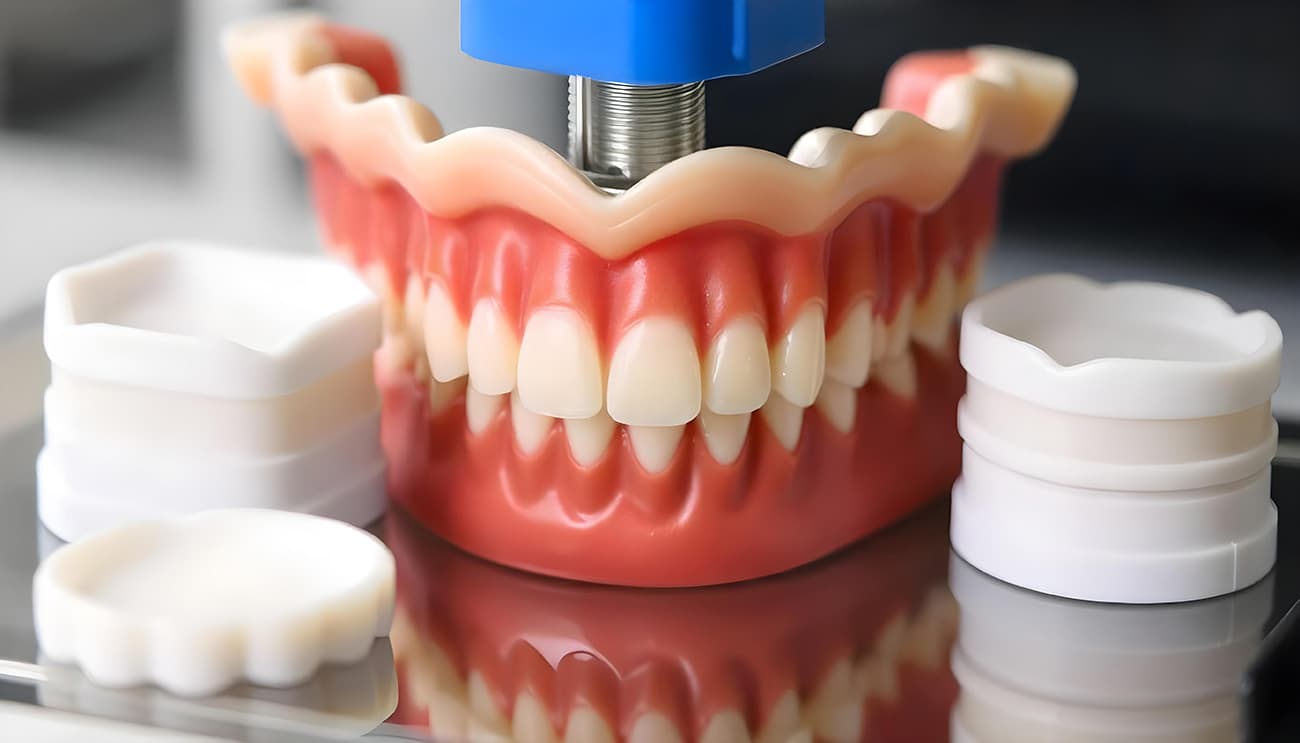3D printing is transforming the way dental facilities around the world are operating and it helps in keeping them competitive. This is largely due to the abundance of 3D printing resins that are constantly being developed.
This information bears a key insight for dentists who are interested in leveraging this technology to enhance patient care and efficiency: the various resins from which dental 3D printing materials are comprised, as well as their different uses. Not only this but the use of resins and 3D printing have changed everything from the way dentists can fill a tooth, make temporary crowns in just one appointment or create working models for surgical procedures, and orthodontic appliances. These are all resin-based 3D printing technologies that get us there quicker with treatment planning. These tools can improve patient outcomes and boost treatment outcomes.
What is Dental 3D Printing?
With the use of additive manufacturing technology, 3D printing within the context of dentistry is a process through which dental components like aligners, crowns, and dentures can easily be developed. 3D printing enables dentists to develop very precise anatomical copies of patients’ mouths and jawbones. It is used to customize parts that are aesthetically compatible to match the patient’s anatomy. In this technique the dental providers use intraoral scanners to create an image of a patient’s teeth and record them in a CAD file. Based on the recorded data one can create implants or molds through 3D printing. Thus simplifying the whole process and providing improved work for patients’ treatment.
What are the Dental 3D Printing Applications?
Listed below are some of the common uses of 3D printing in dentistry:
- Implants: 3D printers, such as SLA and DLP printers, which have high resolution and precision, are good at printing complex shapes like teeth and bones because they produce models with fewer limitations than other types of printing technology. These printed implants are biocompatible and possess the same strength as natural teeth. They could also be applied in dentistry when manufacturing jaw or facial prostheses.
- Crowns and Bridges: Wearable 3D printers for dentistry can produce accurate crowns and both fixed or removable bridges. For the casting of a tooth, you can print out burn-out resins. An intraoral scanner provides the results, and then patterns for casting are printed.
- Surgical Guides: A surgeon may produce surgical guides for drilling and cutting using 3D printers. These guides help surgeons to make surgery simpler.
- Anatomical Replicas and Models: 3D printing enables dentists develop very precise anatomical copies of patients’ mouths and jawbones. Thus allowing them to visualise the patient’s constructs for better intervention.
Benefits of 3D printing in dentistry
Three-D printing offers advanced solutions in dentistry, making it viable to provide specific surgical publications, splints and implants in a faster and more efficient manner. Let’s study the important innovations that are riding an increasing number of dentists to adopt three-D printing answers.
- Cost: In dental labs, 3D printers can reduce the amount of hard work needed to produce dental home equipment, lowering the overall value of manufacturing and allowing first-class production than guide techniques.
- Speed: With 3-D printing workflows in place, the patient’s oral scan may be dispatched to the lab or the 3-D printer in minutes, making production lot faster.
- Usability: 3-D printing technology has now developed with greater automation making the printers easy to use and not requiring specialist training.
- Improved results: The accuracy and precision generated by 3D printing provide patients with better outcomes. As more dental practices implement virtual workflows, the expectancy for correct, speedy, and cost-efficient treatments will develop.
Types of resins used for dental 3D printing
Discover the top resins best suited for digital dentistry and learn about which types of resin you want to use for dental models, temporary crowns and bridge guides used in surgeries, prostheses offered by dentists as well as orthodontic appliances. The relevance of selecting the right kind of resin for accurate and long-lasting treatments as well as dental procedures undertaken with a 3D Printer.
Several resin types with different advantages and disadvantages exist on the market. The market has various resins with distinctive advantages and disadvantages. Here are the three most common categories utilized in dental 3D printing.
Methacrylate based-resins:
These resins are common and have a superb fee-advantage ratio. They result from PolyMethyl MethAcrylate (PMMA) which is a widely applied material in dental prosthetics.
Advantages of methacrylate: Cost-effective, ease of manipulation, dimensional stability, and mechanical strength.
Disadvantages of methacrylate: Lower accuracy in comparison to other materials, May cause inflammation in sensitive patients
Resins based totally on methacrylic acid ester
Methacrylic acid ester is more modern and advanced in comparison to methacrylate. It gives better accuracy and biocompatibility.
Advantages of Methacrylic Acid Ester: Better precision, Better biocompatibility, Suitable for sensitive patients, Less shrinkage at some point of polymerization
Disadvantages of Methacrylic Acid Ester: Cost-effective, Requires specific gadget for processing
Acrylate urethane-based resins
Urethane acrylate resins are a high-performance choice for dental 3D printing. They combine the advantages of methacrylate and methacrylic acid ester, presenting great satisfaction and sturdiness.
Advantages of urethane acrylate: High mechanical power, Dimensional stability, Biocompatibility, Suitable for long-term use
Disadvantages of urethane acrylate: High price, More complex dealing
Factors to consider while choosing a resin
When deciding on the ideal resin for dental 3-D printing, it’s far crucial to keep in mind numerous factors:
- Precision
The resin must allow the creation of models and prostheses with precise and well-defined details.
- Dimensional stability
The resin has to be able to keep its form unaltered upon polymerization thus no deformation or dimensional changes happen.
- Biocompatibility
It must be non-allergic and it shouldn’t irritate patients; in other words, the resin has to be biocompatible.
- Mechanical resistance
The resin must be able to withstand the wear and tear exerted on the prostheses and dental models.
- Print speed: The resin must allow a reasonable printing time, without compromising the quality of the final product.
- Cost: Balance the cost of the resin with its benefits and the value it brings to your practice.
Post-Processing and Handling: Proper post-processing is essential to achieve the desired properties and ensure the safety of 3D-printed dental appliances. The post-processing of printed resins varies from printer to printer. This includes:
- Cleaning: Some resins require several cleaning agents to arrive at an acceptable ready-to-use resin object.
- Curing: Many require time-consuming water jetting to remove support structures, some require a baking process to melt away those supports and a UV curing unit to fully cure the resin, ensuring it reaches its optimal strength and biocompatibility.
- Finishing: Sand and polish the parts as needed to achieve a smooth and aesthetic surface.
Materials employed in 3D (three-dimensional) printing in dentistry are distinct from those found in 3-D (three-dimensional) printing commonly applied in other sectors. Thus, dental 3D printing materials are intended to be safe for dental applications due to their biocompatibility, safety and aesthetics-based designs. Certain resins are explicitly used for anatomical fashions and replicas (called version resins).
Others are designed for implants (draft and castable resins). Additionally, some resins are used for growing temporary dental home equipment, resins that print clear can be used in developing mouth guards, and resins that resemble gingiva for dental implants.
Conclusion
Choosing the ideal resin for dental 3D printing depends on the specific needs of each application and the desired characteristics of the final product. Considering the aforementioned factors, methacrylic acid ester and urethane acrylate-based resins are more advanced options and suitable for most situations. However, methacrylate resins can be a viable alternative in cases where cost is a determining factor.


